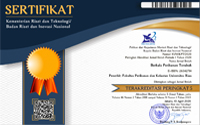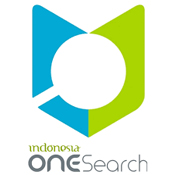Analysis of Alien Species Invasion in Marine Debris in Palu Bay, Central Sulawesi
Abstract
Keywords
Full Text:
PDFReferences
Aliani, S. & Molcard, A. (2003). Hitch-hiking on floating marine debris: macrobenthic species in the Western Mediterranean Sea. Developments in Hydrobiology, Volume 174, pp 59-67
Allsopp, M., Walters, A., Santillo, D. & Johnston, P. (2006). Plastic debris in the world’s oceans, UNEP report, http://www.unep.org/regionalseas/marinelitter/publications/docs/plastic_ocean_report.pdf [accessed 21 May 2015].
Barnes, D.K.A. & Milner, P. (2005). Drifting plastic and its consequences for sessile organism dispersal in the Atlantic Ocean. Marine Biology 146: 815-825.
Barnes, D.K.A., (2002). Biodiversity: Invasions by marine life on plastic debris. Nature 416, 808–809.
Bergmann, M., L. Gutow, & Klages M.. (2015). Marine anthropogenic litter. Springer international publishing AG Switzerland. Springer Science. Business Media. Gothenburg. 447p.
Bomantama R & Simanjuntak J. (2018). LIPI Sebut Morfologi Teluk Palu Jadi Penyebab Besarnya Tsunami. [Internet], diakses pada Oktober 2020. Tersedia pada: https://www.tribunnews.com/nasional/2018/10/02/lipi-sebut-morfologi-teluk-palu-jadi-penyebab-besarnya-tsunami.
Capenter, N. (1998). The Living Seaweeds, Corals, Bivalves and Gastropods. Marine Resource of the Western Central Pacific Vol. 1.
CIESM (2014). Marine litter in the Mediterranean and Black Seas. CIESM Workshop Monograph no 46 (F. Briand, ed.), CIESM Publisher, Monaco, 180 p
Clavero, M. & García-Berthou, E. (2005). Invasive Species Are a Leading Cause of Animal Extinctions. Trends in Ecology and Evolution, 20, 110-119.
De Tender, C. A., Devriese, L. I., Haegeman, A., Maes, S., Ruttink, T. & Dawyndt, P. (2015). Bacterial Community Profiling of Plastic Litter in the Belgian Part of the North Sea, Environmental Science and Technology, 49: 9629−9638.
Dharma, B., (2005). Recent and Fossil Indonesian Shells. PT Mandiriabadi Indonesia.
Dharma, B., (2011). Spesies Marga Anadara Gray dari Indonesia (Mollusca, Bivalvia, Arcidae). Seminar Nasional Mataki I. Jakarta.
Didu, L. & Kasim, M. (2019). Komposisi Jenis dan Kepadatan Makrobiofouling Pada Jaring Kantung Apung Dengan dan Tanpa Menggunakan Sintetik Anti Fouling Hubungannya dengan Pertumbuhan Kappapycus alvarezii Di Perairan Pantai Lakeba Kota Baubau. Jurnal Manajemen Sumber Daya Perairan, 4(2), 111–121.
do Amaral, V S L.R.L. Simone, F.T.S. Tâmega, Ricardo, L. Simone, L. Coutinho, R. & Spotorno-oliveira, P. (2020). New records of the non-indigenous oyster Saccostrea cucullata ( Bivalvia : Ostreidae ) from the southeast and south Brazilian coast. Regional Studies in Marine Science 33 (2020) 100924
Eriksen M., Thiel M., Prindiville M., & Kiessling T. (2018). Microplastic: What Are the Solutions?. In: Wagner M., Lambert S. (eds) Freshwater Microplastics. The Handbook of Environmental Chemistry, vol 58. Springer, Cham.
Gall, S.C., & Thompson R.C. (2015). The impact of debris on marine life. Marine Biology & Ecology Research Centre
García-gómez, J C. Garrigós, M. & Garrigós, J. (2021). Plastic as a Vector of Dispersion for Marine Species With Invasive Potential . A Review. Front. Ecol. Evol. 9:629756. doi: 10.3389/fevo.2021.62975
Ginting E D D, Susetya I E , Patana P, & Desrita. (2017). Identifikasi Jenis-Jenis Bivalvia di Perairan Tanjungbalai, Provinsi Sumatera Utara Province. Acta Aquatica, 4:1 (April, 2017): 13-20
Gregory, M.R. (2009). Environmental implications of plastic debris in marine settings – entanglement, ingestion, smothering, hanger’s on, hitch-hiking and alien invasions. Philosophical Transactions of the Royal Society B: Biological Sciences 364(1526): 2013-2025.
Hermawan R, Adel Y S, Renol, Syahril M, Mubin. (2022). Kajian Mikroplastik pada Ikan Konsumsi Masyarakat di Teluk Palu, Sulawesi Tengah. Journal of Marine Research, Vol 11, No 2 (2022)
Hermawan R, Damar A, & Hariyadi S (2017a). Daily Accumulation and Impacts of Marine Litter on The Shores of Selayar Island Coast, South Sulawesi. Waste Tech. Vol. 5(1)2017:15-20
Hermawan R, Damar A, & Hariyadi S. (2017b). Economic Impact from Plastic Debris on Selayar Island, South Sulawesi. Jurnal Ilmu dan Teknologi Kelautan Tropis, Vol. 9, No. 1, Hlm. 327-336, Juni 2017
Hinojosa, I. Boltaña, S. Lancellotti, D. Macaya, E.Ugalde, P.Valdivia, N.Vásquez, N.Newman, W A. & Thiel, M. (2006). Geographic distribution and description of four pelagic barnacles along the south east Pacific coast of Chile - A zoogeographical approximation. Revista Chilena de Historia Natural. 79: 13-27, 2006
Holmes, A M. Oliver, P G.Trewhella, S.Hill, R.Quigley, & Declan T.G. (2015). Trans-atlantic rafting of inshore Mollusca on Macro-Litter: American molluscs on British and Irish shores, new records. Journal of Conchology. (2015), Vol.42, no.1
Jamil, K & Rombe K.H. (2022). Vegetasi Mangrove Desa Tampara Kecamatan Kaledupa Selatan Kabupaten Wakatobi Provinsi Sulawesi Tenggara. Berkala Perikanan Terubuk; Vol 50 No 1 Februari 2022
Kiessling T., Gutow L., & Thiel M. (2015). Marine Litter as Habitat and Dispersal Vector. In: Bergmann M., Gutow L., Klages M. (eds) Marine Anthropogenic Litter. Springer, Cham. https://doi.org/10.1007/978-3-319-16510-3_6
Marine Species Identification Portal. (2021). [Internet], diakses pada September 2021, tersedia pada: (http://species-identification.org/)
Martinez, A. S. (2012). Spatial distribution of the invasive bivalve Isognomon bicolor on rocky shores of Arvoredo Island (Santa Catarina, Brazil). Journal of the Marine Biological Association of the United Kingdom. 2012, 92(3), 495–503
Mouat J, Lopez Lozano R., & Bateson H. (2010). Economic Impacts of Marine Litter, http://www.kimointernational.org/KIMOPublications.aspx [accessed 13 May 2015].
NOAA. (2017). Marine Debris Program Report Invasive Species Marine Debris as a Potential Pathway for Invasive Species [Internet], diakses pada September 2021. Pada: https://marinedebris.noaa.gov/sites/default/files/publications-files/2017_Invasive_Species_Topic_Paper.pdf
Pitriana, P., Valente, L., von Rintelen, T., Jones, D. S., Prabowo, R. E., & Rintelen, K. von. (2020). An annotated checklist and integrative biodiversity discovery of barnacles (Crustacea, cirripedia) from the moluccas, east Indonesia. ZooKeys, 2020(945), 17–83. https://doi.org/10.3897/zookeys.945.39044
Rachman A B & Thasimmim, S N. (2021). Sosial Budaya Masyarakat Nelayan sebagai Potensi Ekowisata di Pulau Tulang Kabupaten Karimun Provinsi Kepulauan Riau. Berkala Perikanan Terubuk Vol 49 No 2 Juli 2021
Sea life base. (2021). [Internet], diakses pada September 2021, tersedia pada: (https://www.sealifebase.ca/)
Sugianti B, Hidayat E H, Japet N, & Anggraeni Y. (2014). Daftar Pisces yang Berpotensi sebagai Spesies Asing Invasif di Indonesia. Kementerian Kelautan dan Perikanan Badan Karantina Ikan, Pengendalian Mutu dan Keamanan Hasil Perikanan Pusat Karantina Ikan 2014
Sulistiono, S., Kawaroe, M., Madduppa, H., & Prabowo, R E. (2014a). Karakteristik morfologi teritip spons Indonesia. Depik, 3(2). https://doi.org/10.13170/depik.3.2.1553
Sulistiono, S., Kawaroe, M., Madduppa, H., & Prabowo, R. E. (2014b) . Morphological characteristics of Indonesian sponge barnacle. Depik, 3(1), 178–186. https://doi.org/http://dx.doi.org/10.13170/depik.3.2.1553
Sulistiono, S., Setiarina, D. E. M., Prabowo, R. E. 2017. Intertidal Barnacle Community of Ketapang and Gilimanuk Ports That Separated By the Indonesian Throughflow of Bali Strait. Scripta Biologica, 4(4), 207. https://doi.org/10.20884/1.sb.2017.4.4.615
UN Environment (2017). Marine Litter Socio Economic Study. United Nations Environment Programme, Nairobi. Kenya.
Wright S L, Thompson R C, & Galloway T S. (2013). The physical impacts of microplastics on marine organisms: a review. Environ Pollut . 2013 Jul;178:483-92. doi: 10.1016/j.envpol.2013.02.031. Epub 2013 Mar 29.
DOI: http://dx.doi.org/10.31258/terubuk.50.2.1495%20–%201501
Refbacks
- There are currently no refbacks.
Copyright (c) 2022 Roni Hermawan, Anita Treisya Aristawati, Eka Aji Pramita, Mubin Mubin, Rahmi Fitrawati, Finarti Finarti, Mohamad Akbar, Renol Renol, Alismi M Salanggon, Radhiyatul Ula

This work is licensed under a Creative Commons Attribution 4.0 International License.












